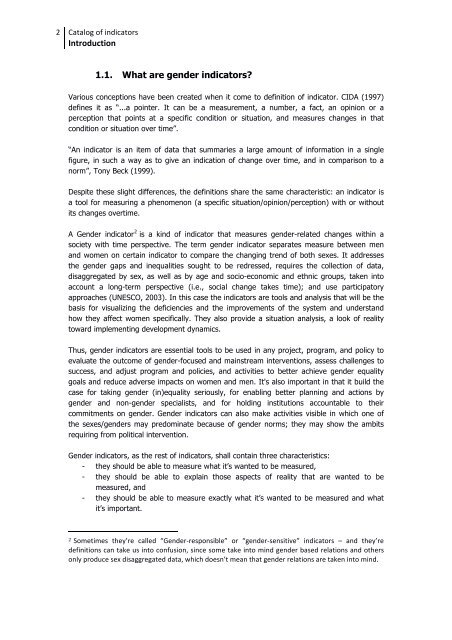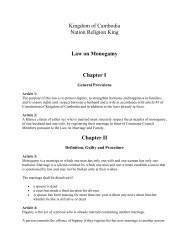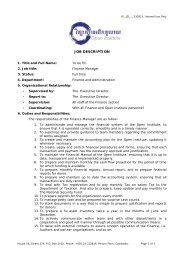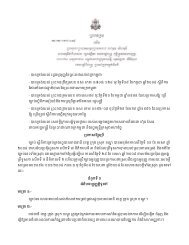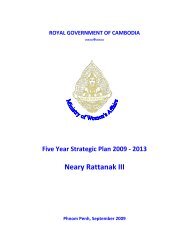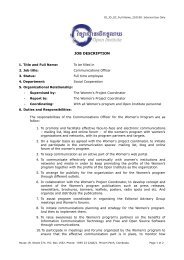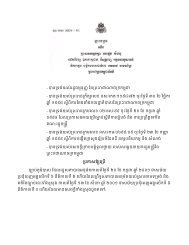Education Education An approach to some basic Indicators for ...
Education Education An approach to some basic Indicators for ...
Education Education An approach to some basic Indicators for ...
You also want an ePaper? Increase the reach of your titles
YUMPU automatically turns print PDFs into web optimized ePapers that Google loves.
2 Catalog of indica<strong>to</strong>rs Introduction 1.1. What are gender indica<strong>to</strong>rs?Various conceptions have been created when it come <strong>to</strong> definition of indica<strong>to</strong>r. CIDA (1997)defines it as “...a pointer. It can be a measurement, a number, a fact, an opinion or aperception that points at a specific condition or situation, and measures changes in thatcondition or situation over time”.“<strong>An</strong> indica<strong>to</strong>r is an item of data that summaries a large amount of in<strong>for</strong>mation in a singlefigure, in such a way as <strong>to</strong> give an indication of change over time, and in comparison <strong>to</strong> anorm”, Tony Beck (1999).Despite these slight differences, the definitions share the same characteristic: an indica<strong>to</strong>r isa <strong>to</strong>ol <strong>for</strong> measuring a phenomenon (a specific situation/opinion/perception) with or withoutits changes overtime.A Gender indica<strong>to</strong>r 2 is a kind of indica<strong>to</strong>r that measures gender-related changes within asociety with time perspective. The term gender indica<strong>to</strong>r separates measure between menand women on certain indica<strong>to</strong>r <strong>to</strong> compare the changing trend of both sexes. It addressesthe gender gaps and inequalities sought <strong>to</strong> be redressed, requires the collection of data,disaggregated by sex, as well as by age and socio-economic and ethnic groups, taken in<strong>to</strong>account a long-term perspective (i.e., social change takes time); and use participa<strong>to</strong>ry<strong>approach</strong>es (UNESCO, 2003). In this case the indica<strong>to</strong>rs are <strong>to</strong>ols and analysis that will be thebasis <strong>for</strong> visualizing the deficiencies and the improvements of the system and understandhow they affect women specifically. They also provide a situation analysis, a look of reality<strong>to</strong>ward implementing development dynamics.Thus, gender indica<strong>to</strong>rs are essential <strong>to</strong>ols <strong>to</strong> be used in any project, program, and policy <strong>to</strong>evaluate the outcome of gender-focused and mainstream interventions, assess challenges <strong>to</strong>success, and adjust program and policies, and activities <strong>to</strong> better achieve gender equalitygoals and reduce adverse impacts on women and men. It's also important in that it build thecase <strong>for</strong> taking gender (in)equality seriously, <strong>for</strong> enabling better planning and actions bygender and non-gender specialists, and <strong>for</strong> holding institutions accountable <strong>to</strong> theircommitments on gender. Gender indica<strong>to</strong>rs can also make activities visible in which one ofthe sexes/genders may predominate because of gender norms; they may show the ambitsrequiring from political intervention.Gender indica<strong>to</strong>rs, as the rest of indica<strong>to</strong>rs, shall contain three characteristics:- they should be able <strong>to</strong> measure what it’s wanted <strong>to</strong> be measured,- they should be able <strong>to</strong> explain those aspects of reality that are wanted <strong>to</strong> bemeasured, and- they should be able <strong>to</strong> measure exactly what it’s wanted <strong>to</strong> be measured and whatit’s important.2 Sometimes they’re called “Gender-‐responsible” or “gender-‐sensitive” indica<strong>to</strong>rs – and they’re definitions can take us in<strong>to</strong> confusion, since <strong>some</strong> take in<strong>to</strong> mind gender based relations and others only produce sex disaggregated data, which doesn’t mean that gender relations are taken in<strong>to</strong> mind.


